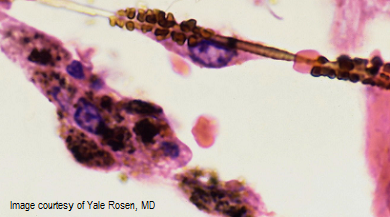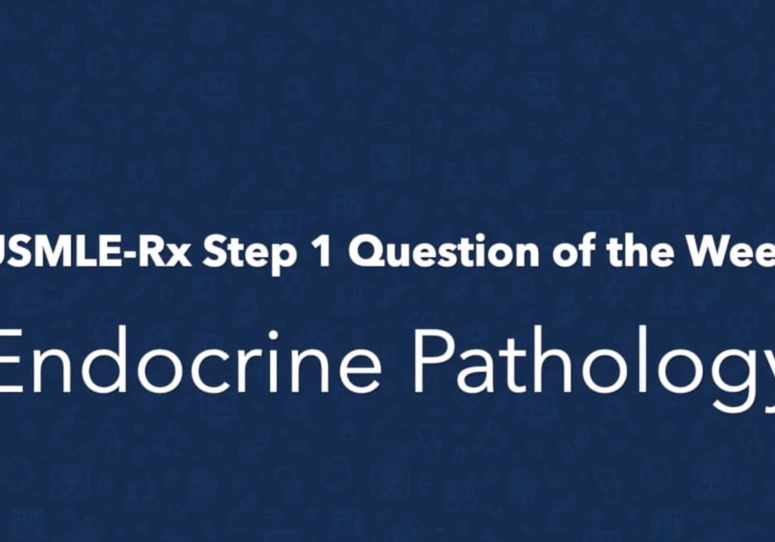Check out today’s Step 1 Qmax Question Challenge.
Know the answer? Post it below! Don’t forget to check back for an update with the correct answer and explanation (we’ll post it in the comments section below).
 A 74-year-old patient presents with increased shortness of breath. A sputum sample reveals golden-brown beaded fibers, like those shown in the image, which result from iron- and protein-coated fibers. On CT scan, a peripheral lesion abbuting the lungs is visualized. A particular pneumoconiosis is suspected.
A 74-year-old patient presents with increased shortness of breath. A sputum sample reveals golden-brown beaded fibers, like those shown in the image, which result from iron- and protein-coated fibers. On CT scan, a peripheral lesion abbuting the lungs is visualized. A particular pneumoconiosis is suspected.
Which of the following is the likely cause of the patient’s condition?
A. Autoimmune attack of lung parenchyma
B. Idiopathic (unknown) origin
C. Living for years in a city with polluted air
D. Long-term complication of steroid abuse
E. Reactivation of a contained primary disease
F. Working in a coal mine for 40 years
G. Working in a shipyard for 40 years
———————–
Want to know the ‘bottom line?’ Purchase a USMLE-Rx Subscription and get many more features, more questions, and passages from First Aid, including images, references, and other facts relevant to this question.
This practice question is an actual question from the USMLE-Rx Step 1 Qmax test bank. For more USMLE Step 1 prep, subscribe to our First Aid Step 1 Flash Facts and First Aid Step 1 Express Videos video series. Score the best deal on all three products as a bundle with USMLE-Rx 360 Step 1.




F
G.
G. This man worked in a shipyard and is suffering from asbestosis.
G. ferruginous bodies shown in image
G
Asbetosis Toxicity showing Ferruginious Bodies
g
Hint: Iron and protein coated fibers. This man has worked in a shipping yard!
The correct answer is G. Working in a shipyard is associated with asbestos exposure. Chronic inhalation of asbestos fibers can result in asbestosis, which is marked histologically by ferruginous bodies that stain rusty red with H&E. Asbestosis, unlike most other pneumoconioses, results in marked predisposition to bronchogenic carcinoma and to malignant mesothelioma. Smoking and asbestos exposure together greatly increase one’s risk of developing bronchogenic carcinoma. The CT shown here demonstrates one sequela of asbestos exposure, calcified pleural plaques.
A is not correct. Asbestosis is not related to an autoimmune phenomenon.
B is not correct. The cause of asbestosis is the inhalation of asbestos fibers into the lungs. Idiopathic restrictive lung diseases include sarcoidosis and idiopathic pulmonary fibrosis.
C is not correct. Living in an urban area for years can cause anthracosis, which is a result of inhalation of carbon dust. It is characterized histologically by carbon-carrying macrophages and results in irregular black patches visible on gross inspection. Anthracosis is harmless.
D is not correct. Ferruginous bodies and ivory-white pleural plaques are not long-term sequelae of steroid abuse.
E is not correct. Tuberculosis has Ghon complexes in primary infection. Cavitary lesions are present in secondary reactivation.
F is not correct.
Working in a coal mine is a risk factor for both “coal workers’ pneumoconiosis” and silicosis. It may be difficult to differentiate between the two, given their similar lung pathology and patient history. Look for findings of “black lungs” on pathology or “eggshell calcifications” on CT to aid in developing the proper diagnosis of coal workers’ pneumonconiosis or silicosis, respectively.
Thank you for explanation .
thank you for the wonderful review.
G
Asbestosa
Espectacular, thanks so much.
Hello are using WordPress for your site platform? I’m new to the blog world but I’m trying to get started and create my own. Do you need any html coding knowledge to make your own blog? Any help would be greatly appreciated!
Heya i? for the first time here. I came across this board and I find It really useful & it helped me out a lot. I hope to give something back and help others like you helped me.
Fantastic beat ! I wish to apprentice while you amend your web site, how could i subscribe for a blog website? The account helped me a acceptable deal. I had been tiny bit acquainted of this your broadcast provided bright clear idea
Hello there! Do you use Twitter? I’d like to follow you if that would be ok. I’m absolutely enjoying your blog and look forward to new posts.
Hello. remarkable job. I did not imagine this. This is a fantastic story. Thanks!
Wow! This could be one particular of the most useful blogs We’ve ever arrive across on this subject. Basically Excellent. I am also an expert in this topic so I can understand your hard work.